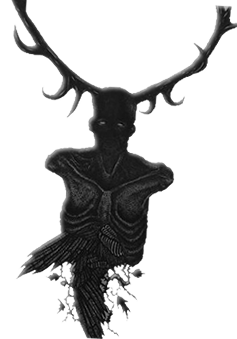
The Wendigo
In Algonquian folklore, the wendigo or windigo is a cannibal monster or evil spirit native to the northern forests of the Atlantic Coast and Great Lakes Region of both the United States and Canada. The wendigo may appear as a monster with some characteristics of a human, or as a spirit who has possessed a human being and made them become monstrous. It is historically associated with cannibalism, murder, insatiable greed, and the cultural taboos against such behaviours. The legend lends its name to the disputed modern medical term Wendigo psychosis, which is considered by psychiatrists to be a form of culture-bound syndrome with symptoms such as an intense craving for human flesh and a fear of becoming a cannibal. In some Indigenous communities, environmental destruction and insatiable greed are also seen as a manifestation of Wendigo Psychosis.
The wendigo is part of the traditional belief system of a number of Algonquin-speaking peoples, most notably the Ojibwe and Saulteaux, the Cree, the Naskapi, and the Innu people. Although descriptions can vary somewhat, common to all these cultures is the view that the wendigo is a malevolent, cannibalistic, supernatural being. They were strongly associated with the winter, the north, and coldness, as well as with famine and starvation. Basil Johnston, an Ojibwe teacher and scholar from Ontario, gives a description of a wendigo: The Wendigo was gaunt to the point of emaciation, its desiccated skin pulled tightly over its bones. With its bones pushing out against its skin, its complexion the ash gray of death, and its eyes pushed back deep into their sockets, the Wendigo looked like a gaunt skeleton recently disinterred from the grave. What lips it had were tattered and bloody [....] Unclean and suffering from suppurations of the flesh, the Wendigo gave off a strange and eerie odor of decay and decomposition, of death and corruption. In Ojibwe, Eastern Cree, Westmain Swampy Cree, Naskapi, and Innu lore, wendigos are often described as giants, many times larger than human beings (a characteristic absent from the myth in the other Algonquian cultures). Whenever a wendigo ate another person, it would grow in proportion to the meal it had just eaten, so that it could never be full. Therefore, wendigos are portrayed as simultaneously gluttonous and emaciated from starvation. The Wendigo is seen as the embodiment of gluttony, greed, and excess: never satisfied after killing and consuming one person, they are constantly searching for new victims.
Human Wendigos
In some traditions, humans who became overpowered by greed could turn into wendigos; the myth thus served as a method of encouraging cooperation and moderation. Also humans could turn into wendigos by being in contact with them for too long.
